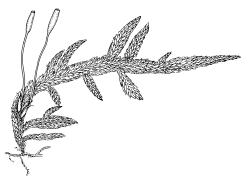Elements in the following description are taken from Buck (1990).
Plants slender to moderately robust, forming shiny, flattened mats. Stems mostly creeping, irregularly to sub-pinnately branched with relatively short, terete or complanate branches; in cross-section with a layer of small, thick-walled cells surrounding larger and thin-walled cells and a distinct central strand. Stem and branch leaves similar, mostly crowded, oblong-lanceolate to oblong-ovate, obtuse to acuminate, usually acute, concave, not decurrent, serrulate above or less commonly entire; margins plane or ± reflexed near base; upper laminal cells linear, straight to ± sinuose, smooth, not porose, commonly shorter at extreme apex; marginal cells not differentiated; basal cells shorter, usually porose; alar cells quadrate to subquadrate (inflated in N.Z. material), with primordial utricles, forming large triangular or ± auriculate groups. Costae double, very short or extending to near mid leaf, occasionally almost absent. Pseudoparaphyllia foliose.
Autoicous or rarely dioicous. Perichaetia scattered on stem and branches, more numerous than perigonia; perichaetial leaves lanceolate to oblong-lanceolate from a sheathing base, erect or reflexed. Perigonia gemmiform, scattered on stem and branches. Setae elongate, yellow or red; capsules cylindric, erect and symmetric or rarely suberect; exothecial cells ± irregularly rectangular; stomata few, restricted to extreme base of urn; columella commonly exserted; annulus present or absent; operculum high-conic to obliquely rostrate. Peristome double; exostome teeth inserted well below the mouth, on outer surface with a nearly straight median line and broad plates, on inner surface not or slightly trabeculate and often perforate; endostome with a low basal membrane, the segments linear, keeled and perforate, or rarely rudimentary; cilia lacking or rarely rudimentary. Calyptra cucullate, mostly naked. Spores spherical, finely or coarsely papillose.
The genus is traditionally divided into two subgenera (sometimes termed sections, as in Brotherus (1925)) based primarily on sporophytic characters, especially seta colour and the presence or absence of an annulus. The N.Z. species belongs to the subgenus Entodon (=sect. Xanthopus Broth.) according to the criteria given by Buck (1990). Buck’s (1990) study of Australian, Melanesian, and Oceanian taxa of Entodon specifically excluded N.Z. material.
Entodon is a genus of c. 130 species (Buck 1990) best developed in tropical highlands but extending into temperate regions of both hemispheres. One species occurs in N.Z.
| Category | Number |
|---|---|
| Indigenous (Non-endemic) | 1 |
| Total | 1 |




